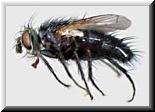Reared specimens examined. Athrycia cinerea (Coquillett): A series of nine adults reared from bertha armyworm collected from Stoney Plain, Alberta in August 1992 (SRCS). Dr. P.G. Mason reports (pers. comm.) on additional reared material in SRCS from: Asquith, Saskatchewan (3 specimens from hosts collected during 13-22.viii.1979), Gronlid, Sask. (8 specimens, 8-22.viii.1979), Biggar, Sask. (6 specimens, 5-19.viii.1988), Wilkie, Sask. (2 specimens, 7.viii.1990), Paynton, Sask. (1 specimen, 30.vii.1991), and Stoney Plain, Alberta (24 specimens, viii.1992).
Athrycia is a mostly Palearctic genus with only one species in North America, A. cinerea (Coquillett). Little was known about the biology of A. cinerea until a bertha armyworm outbreak in the Canadian prairies in the early 1970s roused interest in the hymenopterous and tachinid parasitoids of this pest. Athrycia cinerea was quickly recognized as one of the two most important native parasitoids of bertha armyworm (the other being the ichneumonid Banchus flavescens Cresson), and intensive research on its biology was soon begun (reviewed below). Athrycia impressa (Wulp) and A. trepida (Meigen) are parasitoids of the bertha armyworm relative Mamestra brassicae Walker in the Palearctic region (Turnock 1984; A. trepida cited as A. erythrocera Robineau-Desvoidy).
Athrycia cinerea was known as Blepharigena spinosula (Bigot) or Paraplagia spinosula in the early 1900s because of a misidentification of the Bigot species; spinosula is now recognized as a valid species of Plagiomima Brauer and Bergenstamm (Sabrosky and Arnaud 1965).
Recognition. Athrycia cinerea is easily recognized by the following combination of states: prosternum bare, eye bare, parafacial with 2-3 proclinate stout setae, facial ridge with hairs confined to area immediately above vibrissa, anepimeron with remarkably long seta (longer than length of mid tibia), vein R4+5 haired along length and other veins bare, vein M ending in wing margin well forward of wing tip, and section of vein CuA1 beyond crossvein dm-cu at least as long as preceding section. Typical length is 7-9 mm.
The immature stages of Athrycia cinerea were described and illustrated by Arthur and Powell (1989); the puparium was described and illustrated by Greene (1922) under the name Paraplagia spinulosa (Bigot).
Biology. Research on the biology of Athrycia cinerea was pioneered by H.G. Wylie in the 1970s in Manitoba, and the following summary is based on his first paper on the species (Wylie 1977a). Athrycia cinerea has one generation per year on the Canadian prairies and adults are active from June to August. Females deposit incubated eggs on 3rd to 6th instars of bertha armyworm, with hatching usually taking place within 10 minutes. Larvae burrow into the host and develop in the haemocoel within a respiratory funnel. Larvae develop singly or gregariously in the host, usually but not always exiting from it before forming a puparium. Pupae enter diapause and pass the winter in puparia in the soil. Additional aspects of A. cinerea biology can be found in the papers of Wylie (1977c, 1979), Wylie and Bucher (1977), Turnock (1984, 1988), and Turnock and Bilodeau (1984, 1992).
Athrycia cinerea has been reared from three armyworms (Noctuidae) in addition to bertha armyworm: Pseudaletia unipuncta (Haworth), Spodoptera frugiperda (Smith) and Faronta diffusa (Walker) (Arnaud 1978, Wylie and Ayre 1979). There is also an old record of a sawfly host (Arnaud 1978).
Distribution. Yukon, British Columbia to New Brunswick, south to California, New Mexico and Mexico in the west and south to Virginia in the east (CNC, Sabrosky and Arnaud 1965).


